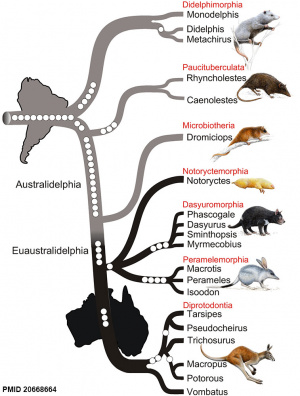Monito del Monte Development: Difference between revisions
mNo edit summary |
mNo edit summary |
||
| Line 74: | Line 74: | ||
:'''Links:''' [[Spermatozoa Development]] | :'''Links:''' [[Spermatozoa Development]] | ||
==Movies== | |||
<html5media width="480" height="360">https://www.youtube.com/embed/NiJ8l4Bq99Q</html5media> | |||
==References== | ==References== | ||
Revision as of 22:53, 8 August 2016
| Embryology - 24 Apr 2024 |
|---|
| Google Translate - select your language from the list shown below (this will open a new external page) |
|
العربية | català | 中文 | 中國傳統的 | français | Deutsche | עִברִית | हिंदी | bahasa Indonesia | italiano | 日本語 | 한국어 | မြန်မာ | Pilipino | Polskie | português | ਪੰਜਾਬੀ ਦੇ | Română | русский | Español | Swahili | Svensk | ไทย | Türkçe | اردو | ייִדיש | Tiếng Việt These external translations are automated and may not be accurate. (More? About Translations) |
Introduction
Monito del monte (Dromiciops gliroides) are small nocturnal marsupials representatives of the ancient order Microbiotheria and also the only known hibernating mammal in South America (Southern Chile and Argentina). Thomas, 1894 original designation Monito del monte (Spanish = "little mountain monkey") or colocolo opossum. Their distribution is within Chile and adjacent Argentina from about 36S to near 43S.
- Links: Category:Marsupial
Some Recent Findings
|
| More recent papers |
|---|
|
This table allows an automated computer search of the external PubMed database using the listed "Search term" text link.
More? References | Discussion Page | Journal Searches | 2019 References | 2020 References Search term: Monito del monte <pubmed limit=5>Monito del monte</pubmed> <pubmed limit=5>Dromiciops gliroides</pubmed> |
Taxon

Taxonomy ID:
Genbank common name: opossum
Rank: species
Genetic code: Translation table 1 (Standard)
Mitochondrial genetic code: Translation table 2 (Vertebrate Mitochondrial)
Lineage ( full )
cellular organisms; Eukaryota; Opisthokonta; Metazoa; Eumetazoa; Bilateria; Deuterostomia; Chordata; Craniata; Vertebrata; Gnathostomata; Teleostomi; Euteleostomi; Sarcopterygii; Dipnotetrapodomorpha; Tetrapoda; Amniota; Mammalia; Theria; Metatheria; Microbiotheria; Microbiotheriidae; Dromiciops
Development Overview
Adult female can produce one litter of a maximum of 4 infants per year. Data below from a 2005 study.[5]
- Intra-uterine development - (3-4 weeks) blastocyst implantation, marsupium development is marked by teat enlargement and formation of lactating tissue.
- parturition - neonates migrate from the vagina to the marsupium.
- intra-marsupium - (2 months) pouched young seem to remain within the marsupium and firmly affixed to teats.
- extra-marsupium - (juvenile) Increased motor capacities allow pouched young to leave the marsupium for short exploratory excursions.
Placenta
Choriovitelline placenta - chorion is formed by the fusion of yolk-sac mesoderm and vessels to the inner face of the serosa.
- Links: Placenta Development
System Development
The marsupial neonate at birth has a variation between the degree of development of different systems.[6]
- well-developed - digestive, respiratory and circulatory system.
- not well-developed - retains fetal excretory system with a fully functional mesonephric kidney and undifferentiated gonads and genitalia.
Oocyte
- Links: Oocyte Development
Spermatozoa
- Links: Spermatozoa Development
Movies
<html5media width="480" height="360">https://www.youtube.com/embed/NiJ8l4Bq99Q</html5media>
References
- ↑ <pubmed>27090740</pubmed>
- ↑ <pubmed>27489568</pubmed>
- ↑ <pubmed>24934187</pubmed>
- ↑ 20668664</pubmed>
- ↑ Muñoz-Pedreros A, Lang, BK Marta Bretos, M. and Meserve, PL. Reproduction and Development of the Monito del Monte, Dromiciops gliroides Thoma (marsupialia: Microbiotheriidae) in Temperate Rainforests of Southern Chile. (2005) Gayana 69(2):225-233 DOI: 10.4067/S0717-65382005000200002 PDF
- ↑ <pubmed>11999321</pubmed>
Reviews
<pubmed></pubmed> <pubmed></pubmed> <pubmed></pubmed>
Articles
<pubmed></pubmed> <pubmed></pubmed> <pubmed>20668664</pubmed>
Muñoz-Pedreros A, Lang, BK Marta Bretos, M. and Meserve, PL. Reproduction and Development of the Monito del Monte, Dromiciops gliroides Thoma (marsupialia: Microbiotheriidae) in Temperate Rainforests of Southern Chile. (2005) Gayana 69(2):225-233 DOI: 10.4067/S0717-65382005000200002 PDF
Books
Brown BE. Atlas of New World marsupials (2004) Field Museum of Natural History.
Search PubMed
Search PubMed: Monito del monte development | Dromiciops gliroides
External Links
External Links Notice - The dynamic nature of the internet may mean that some of these listed links may no longer function. If the link no longer works search the web with the link text or name. Links to any external commercial sites are provided for information purposes only and should never be considered an endorsement. UNSW Embryology is provided as an educational resource with no clinical information or commercial affiliation.
- Internet Archive
- Darin Croft south american fossil mammals
- EDGE of Existence species 169
Glossary Links
- Glossary: A | B | C | D | E | F | G | H | I | J | K | L | M | N | O | P | Q | R | S | T | U | V | W | X | Y | Z | Numbers | Symbols | Term Link
Cite this page: Hill, M.A. (2024, April 24) Embryology Monito del Monte Development. Retrieved from https://embryology.med.unsw.edu.au/embryology/index.php/Monito_del_Monte_Development
- © Dr Mark Hill 2024, UNSW Embryology ISBN: 978 0 7334 2609 4 - UNSW CRICOS Provider Code No. 00098G


